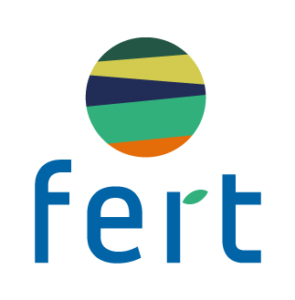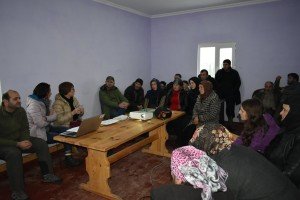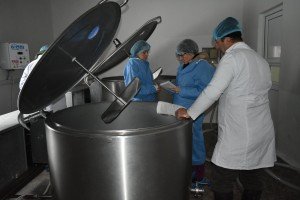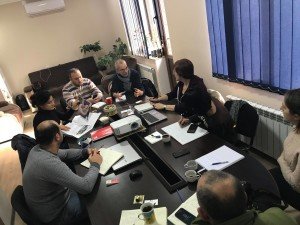From December 10 to 15, 2018, Corinne Gomel completed her 13th mission with GBDC technicians in Georgia. A dairy production engineer at Savencia Dairy Resources*, Corinne has been involved in this partnership with the GBDC and Fert since 2013, which aims to improve milk quality and productivity in the Samtskhe-Javakheti region of Georgia. In three questions, she discusses the main issues that guided this last mission.
1.What is Savencia Dairy Resources’ intervention in Georgia?
The objective pursued by the farmers, and therefore by the Georgian technicians who accompany them, is to provide local dairies with regular milk of a quality that meets their expectations. The core of my work with the GBDC technicians is therefore to make them question the quality of the milk produced on the farms. The first step was to understand the expectations of local dairies – those of Uraveli, Benara or Zanavi – regarding milk quality. If the technicians are not destined to become experienced cheesemakers, their positioning upstream of the milk production conditions on the farm will influence the production of quality milk, which must then not deteriorate until it is put into production.
This work proved complex because the dairies themselves have difficulty formalizing their expectations in this area. What is quality? For the actors in the dairy industry, where some farmers themselves sometimes work, this notion of quality often remains a nebulous one.
However, we were able to list problems encountered at the farm level that affected milk quality: the recurrence of mastitis, the general health of the animals, the fluctuating feed ration. With, at the end, a milk that knows far too many variations. There is also no standardised monitoring and control of the milk when it arrives at the dairy, nor is there any competent staff to receive it.
Then working on the composition of the milk led us to mention the balance of the ration as the number one concern in the advice to farmers.
2. What are the areas for improvement that you have identified so that farmers – and the technicians who support them – can improve their practices?
Different levers for improvement on the farm have been identified by the technical team to achieve better milk quality on arrival at the dairy: working on the food ration to avoid variations in fat and protein content, paying greater attention to milking hygiene, or using appropriate veterinary treatments to eliminate germs responsible for mastitis.
For me, these are exciting missions because it is really a question of doing a work of animation to “make the actors give birth”, to get them to express their problems first, and then to think about how to solve them. In this respect, I position myself as a bit of a “coach” towards the GBDC team. But my mission in this GBDC-Fert-Savencia partnership is also to transfer skills to them.
3.This December 2018 mission was your 13th mission to the GBDC in Georgia. What progress have you seen since your first mission in 2013?
I gradually see that the training is bearing fruit as educational tools have been developed and made available to farmers so that they can visualize their progress in livestock management. Tools that trigger exchanges between technicians and producers. Thanks to the combined efforts of all the actors in this partnership, but first and foremost those of the breeders, I note that the GBDC technicians are more comfortable in this role of advising breeders. Over time, they take on this advisory posture and become more and more comfortable. I often tell them that they will benefit from remaining generalist to bring a global vision of livestock to the producers they support. However, they must improve active listening to detect the levers and obstacles expressed by farmers in their exchanges.
More concretely, I note the team’s progress in setting up tools to monitor production conditions: farm monitoring questionnaires are in place with questions on animal feeding and housing, milking conditions and practices, the health aspect of livestock buildings or more recently on milk quality. These tools are now appropriate for teams who feel all the more comfortable in supporting farmers. Relationships are more fluid and relevant, the team succeeds in ensuring a follow-up of the farms, thanks in particular to these tools which guarantee interaction with the farmers.
The aim of our action remains above all to improve milk productivity in the region and therefore the evolution of livestock farmers in their breeding practices. Progress has been observed among livestock farmers who have improved their buildings, watering, grazing or ration balance; some have implemented artificial insemination, others have worked on the health of their herds, including vaccination. These are levers for improvement that required little investment. Thus, out of 105 farms monitored between 2013 and 2017, we found:
- A 6.8% increase in average production per cow,
- An improvement in the quality and quantity of feed in cow rations (e.g. an increase in the quantity of dry matter provided per cow per day, which is more significant at +23%),
- An improvement in the condition of the stables (ventilation, mulching and cleanliness, less dust).
But I was also able to measure during this mission that the project was spreading: pastoralists from the village of Derzeli, although landlocked, heard about the actions implemented thanks to the team’s advice and called on the GBDC to benefit from it. This type of indicator is particularly positive and rewarding for technicians.
For my part, what I find particularly interesting in my mission is the fact of bringing breeders into a dynamic of progress, of making them question themselves on their problems, of being in this position of animation so that they have a global vision of their problems and that they themselves find solutions to solve them.
*Committed to an ethical and socially responsible sustainable world, the Savencia group is committed to contributing every day to the good food and the common good. As part of its CSR approach, the French milk purchasing subsidiary Savencia Ressources laitières made a commitment to Fert in 2013.







